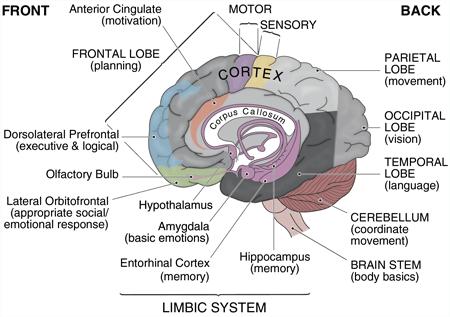Introduction
Amnesia refers to a significant deficit in memory function that affects the ability to encode, store, and retrieve information. It can arise due to neurological damage, traumatic injury, or neurodegenerative disorders. The condition is broadly classified into different types based on its nature and cause, including anterograde and retrograde amnesia. A deeper understanding of the biological basis of it sheds light on the critical brain structures involved in memory processing, such as the hippocampus, thalamus, and cerebral cortex.
Types of Amnesia
The two important types include-

Anterograde Amnesia and Retrograde Amnesia
1. Anterograde Amnesia
Anterograde amnesia is characterized by an inability to form new memories following the onset of brain injury. It is commonly observed after traumatic brain injury (TBI), especially concussions, and in neurological conditions such as Alzheimer’s disease. Damage to the hippocampus and medial temporal lobe structures impairs the consolidation process, which is crucial for transferring short-term memories into long-term storage. This disruption often results in individuals being unable to recall events that occurred after the injury, while past memories may remain intact (Squire & Wixted, 2011).
2. Retrograde Amnesia
Retrograde amnesia involves the loss of memories formed before the onset of the condition. The extent of memory loss varies, with more recent memories being more vulnerable due to their weaker consolidation compared to older memories that have undergone extensive reprocessing (Moscovitch et al., 2005). In cases of traumatic brain injury or concussion, retrograde amnesia results from disruptions in neural connectivity between the hippocampus and cortical storage sites. Damage to the prefrontal cortex and diencephalic structures can significantly impair memory retrieval processes.
Amnesia Related Problems
Some of the problems that presents amnesia like symptoms include-
1. Amnesia After Concussion
A concussion is a mild form of TBI that often results in both anterograde and retrograde amnesia. The mechanical impact of a concussion can lead to diffuse axonal injury (DAI), disrupting synaptic communication and causing temporary or permanent memory deficits (Giza & Hovda, 2014). Research indicates that concussion-related amnesia is due to transient neurochemical imbalances, including increased glutamate release and calcium influx, which contribute to neuronal dysfunction (Shaw, 2002). While retrograde amnesia following a concussion is usually temporary, anterograde amnesia can persist for an extended period, depending on the severity of the trauma (McKee & Robinson, 2014).
2. Korsakoff Syndrome
Korsakoff syndrome is a chronic memory disorder associated with prolonged alcohol abuse and severe thiamine (vitamin B1) deficiency.
- The condition primarily affects the diencephalon, including the thalamus and mammillary bodies, structures vital for memory consolidation (Kopelman et al., 2009).
- Thiamine deficiency disrupts glucose metabolism in neurons, leading to widespread cell death and atrophy in memory-related areas.

Wernicke-Korsakoff Syndrome
Individuals with Korsakoff syndrome exhibit severe anterograde amnesia, frequently accompanied by confabulation, a phenomenon where fabricated memories are unconsciously generated to fill gaps in recollection (Bergman et al., 2014). Although early intervention with thiamine supplementation can prevent further deterioration, memory deficits are often irreversible due to the extensive neural damage (Victor et al., 1989).
3. Alzheimer’s Disease and Amnesia
Alzheimer’s disease is a progressive neurodegenerative disorder characterized by gradual cognitive decline and memory impairment.
- The early stages of Alzheimer’s are marked by anterograde amnesia, where individuals struggle to form new memories due to hippocampal degeneration (Jack et al., 2010).
- As the disease progresses, retrograde amnesia becomes more pronounced, affecting older memories stored in the neocortex (Hyman et al., 2012).

Alzheimer’s Disease
The biological basis of memory impairment in Alzheimer’s disease involves the accumulation of beta-amyloid plaques and tau protein tangles, leading to synaptic dysfunction and neuronal apoptosis (Hardy & Selkoe, 2002). Cholinergic deficits, where reduced acetylcholine levels further contribute to memory decline, also play a significant role. Current treatments, such as acetylcholinesterase inhibitors, aim to temporarily enhance neurotransmission but do not halt disease progression (Sperling et al., 2011).
Biological Basis of Amnesia
Amnesia is fundamentally linked to disruptions in brain structures responsible for memory encoding, consolidation, and retrieval. Key regions implicated in amnesia include-

Brain Areas
- Hippocampus- Essential for encoding and consolidating new memories; damage leads to anterograde amnesia (Squire et al., 2004).
- Prefrontal Cortex- Plays a role in memory retrieval and working memory; damage impairs recall ability (D’Esposito & Postle, 2015).
- Thalamus and Mammillary Bodies- Important for memory processing and retrieval; affected in Korsakoff syndrome (Harding et al., 2000).
- Neocortex- Stores long-term memories; progressive degeneration leads to retrograde amnesia in Alzheimer’s disease (Hyman et al., 2012).
Conclusion
Amnesia presents in multiple forms depending on the underlying neurological damage or disease. Whether resulting from transient disruptions due to concussion or the progressive neuronal loss seen in Alzheimer’s disease, memory impairment underscores the brain’s intricate neural networks responsible for cognition and recollection. Insights from broader neuroscientific studies provide a clearer understanding of the mechanisms underlying it and potential avenues for therapeutic intervention.
References
Squire, L. R., & Wixted, J. T. (2011). The cognitive neuroscience of human memory since H.M. Annual Review of Neuroscience, 34, 259-288.
Moscovitch, M., et al. (2005). Functional neuroanatomy of remote episodic, semantic and spatial memory: A unified account based on multiple trace theory. Journal of Anatomy, 207(1), 35-66.
Giza, C. C., & Hovda, D. A. (2014). The new neurometabolic cascade of concussion. Neurosurgery, 75(suppl_4), S24-S33.
Shaw, N. A. (2002). The neurophysiology of concussion. Progress in Neurobiology, 67(4), 281-344.
Kopelman, M. D., et al. (2009). The Korsakoff syndrome: Clinical aspects, psychology, and treatment. Alcohol and Alcoholism, 44(2), 148-154.
Jack, C. R., et al. (2010). Hypothetical model of dynamic biomarkers of the Alzheimer’s pathological cascade. The Lancet Neurology, 9(1), 119-128.
Hardy, J., & Selkoe, D. J. (2002). The amyloid hypothesis of Alzheimer’s disease: Progress and problems on the road to therapeutics. Science, 297(5580), 353-356.
Sperling, R. A., et al. (2011). Toward defining the preclinical stages of Alzheimer’s disease: Recommendations from the National Institute on Aging. Alzheimer’s & Dementia, 7(3), 280-292.
Dr. Balaji Niwlikar. (2025, February 3). 2 Important Types of Amnesia and 3 Important Presentation of Amnesia Related Illnesses. Careershodh. https://www.careershodh.com/amnesia/
